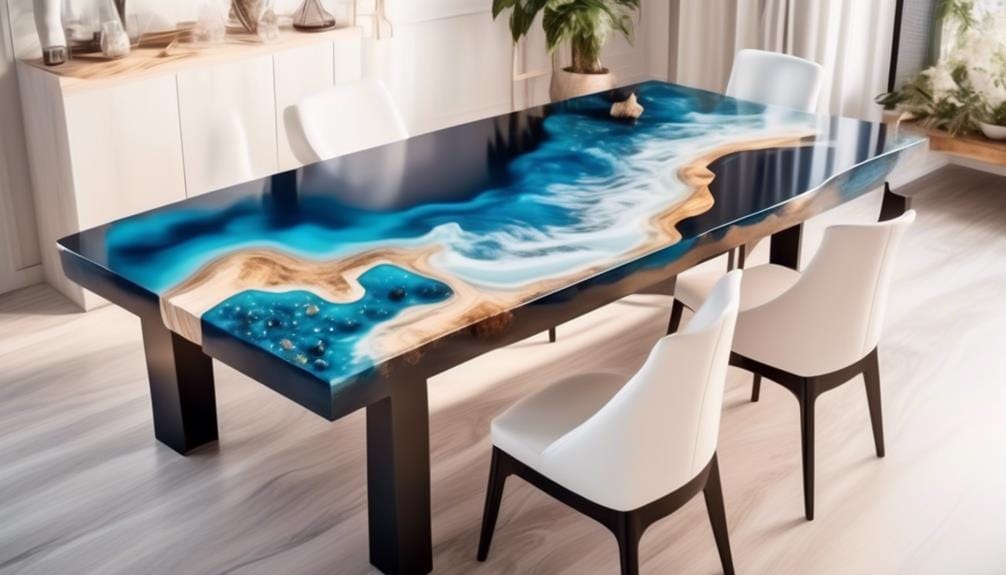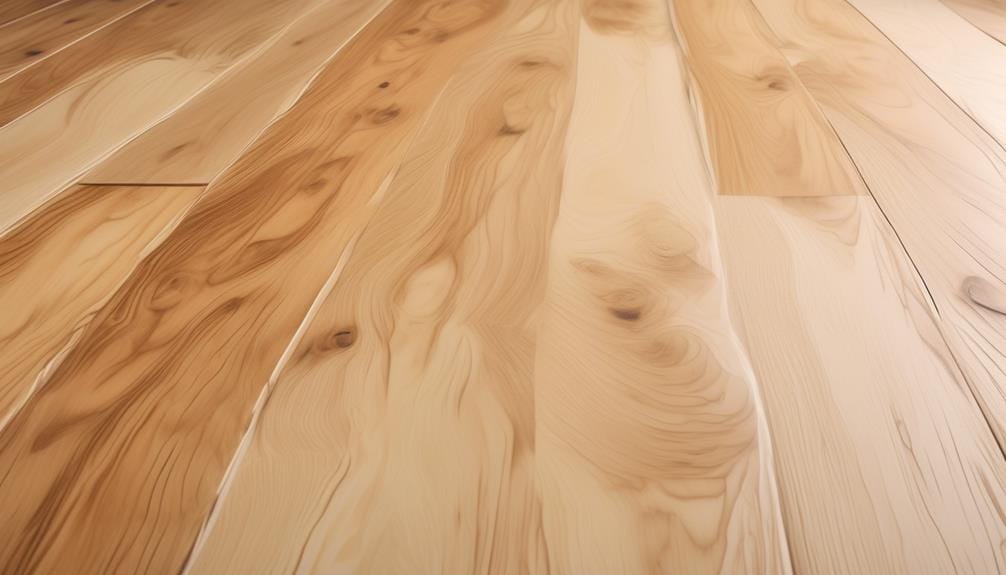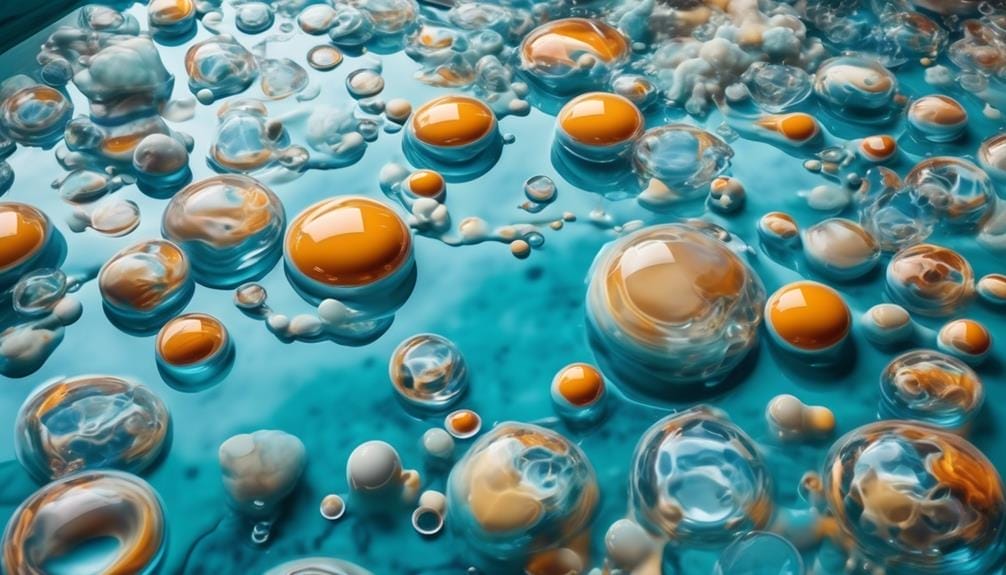You’ve probably heard the saying, ‘Smooth as glass.’ Well, imagine being able to achieve that level of smoothness and clarity in your projects.
Enter Low-Viscosity Deep Pour Epoxy, a game-changer in the world of resin. This high-quality solution offers a low-viscosity formula, making it incredibly easy to work with and ensuring a flawless finish.
But that’s just the beginning. There’s so much more to discover about the advantages, applications, and techniques of using Low-Viscosity Deep Pour Epoxy.
So, buckle up and get ready to embark on a journey that will leave you amazed and inspired.
Key Takeaways
- Low-Viscosity Deep Pour Epoxy is a versatile and high-performance resin that allows for thick pours of 2 to 4 inches in one application.
- It is ideal for projects like river tables, countertops, and artistic creations due to its low-viscosity formula that ensures even spreading without trapping air bubbles.
- The deep pour capability of this epoxy allows for pouring thick layers without overheating or cracking.
- It provides a smooth and uniform finish with improved flow and coverage, UV resistance for maintaining clarity and color, and effortless bubble removal during the curing process.
What Is Low-Viscosity Deep Pour Epoxy?
Low-Viscosity Deep Pour Epoxy is a versatile and high-performance resin that allows for thick pours of 2 to 4 inches in one application, making it ideal for a wide range of projects such as river tables, countertops, and artistic creations. This epoxy resin has a low viscosity, which means it has a thin consistency and flows easily. This characteristic is crucial when pouring thick layers because it ensures that the epoxy spreads evenly without trapping air bubbles.
The deep pour capability of this epoxy resin refers to its ability to be poured in thick layers without overheating or cracking. Traditional epoxy resins have limitations when it comes to pouring thick layers, as they can generate excessive heat during the curing process. Low-Viscosity Deep Pour Epoxy, on the other hand, is specially formulated to handle thicker pours, allowing you to achieve the desired thickness in one application.
The low viscosity and deep pour capability of this epoxy resin make it a preferred choice for various projects. Whether you’re creating a river table with flowing resin or crafting a unique countertop with intricate designs, this epoxy resin provides the perfect balance of flowability and thickness. It’s designed to deliver a bubble-free, crystal clear, high gloss finish that enhances the beauty of your creations.
Additionally, the UV resistance of this epoxy resin ensures that your projects maintain their clarity and color over time, even when exposed to sunlight.
Advantages of Using Low-Viscosity Deep Pour Epoxy
When using low-viscosity deep-pour epoxy, you can expect improved flow and coverage. The resin has a thinner consistency that allows it to spread more easily and evenly. This results in a smoother and more uniform finish, with reduced chances of uneven patches or incomplete coverage.
Additionally, the low viscosity helps to minimize the formation of air bubbles. This ensures a bubble-free and flawless surface.
Improved Flow and Coverage
To enhance the flow and coverage of your deep pours, consider utilizing the advantages of low-viscosity deep-pour epoxy. This type of epoxy offers exceptional flow and coverage, providing a crystal-clear finish for river tables, countertops, and artwork. With its low viscosity, it allows for deep pours of 2-4 inches, reducing the need for multiple layers and saving you valuable time. The smooth and bubble-free surface it creates eliminates the need for additional steps to remove bubbles, ensuring a seamless and professional result. Made in the USA with unmatched quality, this low-viscosity deep-pour epoxy is not only food-safe and odorless but also has zero VOC characteristics. Please take advantage of the improved flow and coverage it offers and achieve flawless and stunning deep-pour projects.
| Advantages of Low-Viscosity Deep Pour Epoxy | ||
|---|---|---|
| Exceptional flow and coverage | Reduced need for multiple layers | Bubble-free and smooth surface |
| Crystal clear finish | Time-saving | Made in the USA |
| Food-safe and odorless | Zero VOC characteristics | Includes free epoxy tool kit |
| Fast 2-day delivery | Deep pour epoxy calculator for precise measurements |
Reduced Air Bubbles
To achieve a flawless and crystal-clear finish, the reduced air bubbles in the deep pour epoxy effortlessly rise to the surface during curing, eliminating the need for additional steps to remove bubbles. This innovative feature is made possible by the low-viscosity formulation of the deep-pour epoxy.
Here are three advantages of using this low-viscosity deep-pour epoxy with reduced air bubbles:
- Superior Air Release: The low-viscosity formulation ensures that air is released easily from the epoxy, preventing the formation of bubbles. This results in a smooth and bubble-free surface, perfect for applications such as river tables and artwork.
- Effortless Bubble Removal: With the reduced air bubbles in the epoxy, there’s no need for tedious additional steps to remove bubbles. The bubbles rise to the surface during the curing process, leaving behind a flawless finish.
- Crystal-Clear Resin: The deep pour epoxy’s reduced air bubbles guarantee a clear and transparent finish, enhancing the overall aesthetic appeal of your project.
Applications for Low-Viscosity Deep Pour Epoxy

Low-viscosity deep-pour epoxy offers a range of applications in woodworking. It provides a strong and beautiful finish for furniture, woodworking projects, and wooden artwork. Additionally, it’s highly beneficial for art projects, enabling artists to create clear and glass-like finishes with unmatched clarity.
In the construction industry, low-viscosity deep-pour epoxy can be used for various applications. It can encapsulate projects and create thick resin surfaces like bar tops and countertops.
Uses in Woodworking
In woodworking applications, the deep pour capability of 2-4 inches makes low-viscosity deep pour epoxy ideal for creating stunning river tables, live edge pours, and wooden art projects.
This type of epoxy casting is perfect for encapsulating decorative items, making jewelry, and crafting figurines and prototypes.
Its crystal-clear, bubble-free, high gloss finish adds a professional touch to any woodworking project.
Additionally, low-viscosity deep-pour epoxy is suitable for laminating and wood epoxy projects, offering unmatched clarity and inherent strength for furniture, wooden artwork, and other woodworking applications.
It’s easy handling and long working time of 80 minutes make it versatile for various woodworking projects with different curing and de-mold times.
Benefits of Art Projects
With its ability to create deep pours of 2 to 4 inches in one application, deep pour epoxy offers a range of benefits for art projects in woodworking applications. The resin provides a bubble-free, crystal clear, high gloss finish, ensuring professional and high-quality results for your artwork.
Its UV resistance and scratch resistance properties also ensure that your creations will maintain their clear finish over time, even when exposed to sunlight or regular handling. The long working time of 80 minutes allows for easy mixing and handling, providing ample time for intricate art projects.
Additionally, the low odor of the epoxy makes it safe for indoor use, creating a pleasant working environment. The compatibility with various coloring agents, such as mica powder and alcohol ink, offers artists the flexibility to create unique and customized art pieces.
Applications in Construction
For construction applications, deep pour epoxy offers a versatile solution with its low-viscosity properties. It is ideal for a wide range of projects, including creating river tables, bar tops, countertops, and live edge tables. Deep-pour epoxy can also be used for encapsulating and doming decorative items, completing art projects, and making jewelry, figurines, prototypes, and other models. Additionally, it is suitable for laminating and wood epoxy projects, such as furniture, woodworking, and wooden artwork, providing a clear finish and inherent strength. Its compatibility with various substrates, pigments, dyes, and powders allows for the creation of unique and customized designs. Whether for small repairs or large desk pours, deep-pour epoxy offers a glass-like finish for both indoor and outdoor construction applications.
How to Properly Prepare Surfaces for Deep Pour Epoxy

To properly prepare surfaces for deep pour epoxy, ensure they’re clean, dry, and free of dust and debris. This is crucial for achieving a strong and durable bond between the epoxy and the surface.
Before applying the epoxy, it’s recommended to sand the surface to create a rough texture. This rough texture improves adhesion and allows the epoxy to bond better with the surface.
Additionally, using a primer or sealant can further enhance the bond between the surface and the deep-pour epoxy. The primer or sealant acts as a barrier, preventing any potential issues that may arise due to moisture or contaminants on the surface.
Moreover, it’s important to seal any cracks or gaps in the surface prior to applying the deep-pour epoxy. This prevents the epoxy from leaking or seeping through and ensures a smooth and even application.
Lastly, consider using a barrier coat or mold release to facilitate easy removal of the cured epoxy from the surface, if necessary.
Properly preparing the surfaces is essential for achieving optimal results when using deep-pour epoxy.
Step-by-step Guide for Mixing and Pouring Low-Viscosity Deep Pour Epoxy
Begin by measuring out the Low-iscosity Deep deep-pour epoxy and the accompanying hardener in a 2:1 ratio by weight. This ensures the proper blending of the materials. Once you have the correct measurements, you can proceed with the mixing and pouring process.
Here is a step-by-step guide to help you through:
- Step 1: Prepare the workspace by ensuring it’s clean and free from any dust or debris. This will help ensure a smooth and professional finish.
- Step 2: Use a mixing container that’s large enough to accommodate the amount of epoxy you’ll be working with. Pour the epoxy component into the container first, followed by the hardener component.
- Step 3: Mix the epoxy and hardener thoroughly for at least 3-4 minutes. Be sure to scrape the sides and bottom of the container to ensure complete mixing.
- Step 4: Once the mixture is well blended, you can begin pouring it onto your desired surface. Take your time and pour slowly to avoid any air bubbles.
- Step 5: After pouring, use a propane torch to remove any surface bubbles. Gently wave the torch over the epoxy, being careful not to hold it too close or for too long.
- Step 6: Allow the epoxy to cure for the recommended de-mold time of 24-72 hours, depending on the thickness of your casting. Be patient and avoid disturbing the epoxy during this time.
Tips for Achieving Bubble-Free Results With Low-Viscosity Deep Pour Epoxy

To achieve bubble-free results with low-viscosity deep-pour epoxy, you need to employ effective bubble-prevention techniques and follow proper mixing instructions.
One important technique is using a propane torch to remove surface bubbles after mixing.
Additionally, make sure to use mixing cups that are suitable for the amount of resin needed and allow for longer curing time compared to other resins.
Bubble Prevention Techniques
Using a propane torch to eliminate surface bubbles during the drying process is an effective technique for achieving bubble-free results with low-viscosity deep-pour epoxy. By carefully applying heat to the surface of the epoxy, the trapped air bubbles rise to the surface and burst, leaving a smooth and flawless finish.
However, bubble prevention begins even before the epoxy is poured. Accurate measuring and thorough mixing of the epoxy components minimize the formation of bubbles. Additionally, allowing the epoxy to cure slowly can result in crystal clear and bubble-free resin projects. It’s also advisable to practice with the resin before using it in important projects to become familiar with its properties and potential bubble formation.
Checking for any leakage of Part B hardener in the packaging before use is crucial to ensure the effectiveness of bubble prevention techniques.
Proper Mixing Instructions
To achieve bubble-free results with low-viscosity deep-pour epoxy, it is crucial to follow proper mixing instructions. The mix ratio for LV Epoxy Resin should be 2 parts resin to 1 part hardener by weight. Using the provided mixing cups may not be suitable for larger projects, so consider using alternative containers. It is important to mix the resin and hardener thoroughly to ensure a clear and even pour. Surface bubbles formed during mixing can be eliminated by using a propane torch. Take your time and practice handling the resin to avoid streaks and achieve the best results. Additionally, keep in mind that deep-pour epoxy may require more time for full curing compared to other resins, so be patient for a flawless and bubble-free finish.
| Mixing Instructions |
|---|
| Use a 2:1 mix ratio by weight |
| Consider using alternative containers for larger projects |
| Mix resin and hardener thoroughly |
| Remove surface bubbles with a propane torch |
| Practice handling to avoid streaks |
| Allow more time for full curing |
Note: Deep pour epoxy may require longer curing time compared to other resins.
Curing and Drying Times for Low-Viscosity Deep Pour Epoxy
The curing and drying times for low-viscosity deep pour epoxy range from 24 to 72 hours, depending on the thickness of the pour. This versatile epoxy offers a fast and efficient curing process, allowing you to complete your projects within a reasonable timeframe.
Here are three key points to consider regarding the cure and dry times for low-viscosity deep-pour epoxy:
- Thickness Matters: The cure time of low-viscosity the thickness of the pour directly influences deep-pour epoxy. Thicker pours will require a longer curing time, typically closer to the 72-hour mark. On the other hand, thinner pours may cure within the shorter 24-hour timeframe. It’s important to take this into account when planning your project timeline.
- Efficient Deep Pour Capabilities: The deep pour capabilities of this epoxy allow for pours between 2-4 inches, eliminating the need for multiple pours and saving you valuable time. With the ability to pour larger quantities at once, you can achieve efficient and consistent results without the hassle of multiple curing and drying cycles.
- Bubble-Free Finish: The low-viscosity formulation of this epoxy is designed to allow bubbles to rise to the surface as it cures. This process ensures a bubble-free and crystal-clear finish without the need for additional steps or interventions. This saves you time and effort, resulting in a flawless end product.
Understanding the cure and dry times for low-viscosity deep-pour epoxy is crucial for planning and executing your projects effectively. By considering the thickness of your pour, taking advantage of efficient deep pour capabilities, and appreciating the bubble-free finish, you can achieve optimal results in a timely manner.
How to Sand and Finish Surfaces Coated With Low-Viscosity Deep Pour Epoxy

There are several steps to follow to achieve a smooth and glossy finish on surfaces coated with low-viscosity deep-pour epoxy.
- First, carefully remove any surface bubbles using a propane torch. This will help to ensure a bubble-free finish.
- After removing the bubbles, gently sand the surface with fine-grit sandpaper (400-600 grit). This will help to level out any imperfections and create a uniform texture.
- Start by lightly sanding the surface in a circular motion and applying even pressure. Periodically check the surface to monitor your progress.
- Be cautious not to overspend or apply too much pressure, as this can damage the epoxy coating.
- Once you have achieved a smooth surface, wipe it down with a tack cloth to remove any sanding residue. This step is crucial to ensure a clean and debris-free surface for the next step.
- To enhance the gloss and durability of the surface, apply a topcoat of clear epoxy resin. Follow the manufacturer’s instructions for mixing and applying the topcoat.
- Allow the finished surface to cure for the recommended time before using or handling it to ensure optimal results.
Maintenance and Care for Projects Made With Low-Viscosity Deep Pour Epoxy
For optimal maintenance and care of projects made with low-viscosity deep-pour epoxy, it’s essential to implement proper cleaning and protective measures. Follow these guidelines to ensure the longevity and beauty of your epoxy projects:
- Clean with a gentle solution: Use a mild, non-abrasive cleaner to remove dirt and debris from the surface of your epoxy project. Avoid harsh chemicals or abrasive scrubbers, as they can damage the epoxy finish.
- Protect from heat and UV exposure: Low-viscosity deep-pour epoxy is highly resistant to heat and UV rays, but prolonged exposure can still affect its durability. To prevent discoloration or warping, avoid placing your epoxy project in direct sunlight or near sources of excessive heat.
- Avoid sharp objects and heavy impact: While low-viscosity deep-pour epoxy is known for its durability, it’s still susceptible to scratches and dents. Take care to avoid dragging sharp objects across the surface and protect the project from heavy impact or weight.
Frequently Asked Questions About Low-Viscosity Deep Pour Epoxy

Are you looking to learn more about low-viscosity deep-pour epoxy? Here are some frequently asked questions to help you understand this versatile and innovative product.
Q: How thick can low-viscosity deep-pour epoxy be poured?
A: Low-viscosity deep-pour epoxy can be poured 2 to 4 inches thick in one go, making it convenient and time-saving for various applications such as countertops, river tables, and artwork.
Q: Does low-viscosity deep-pour epoxy produce bubbles?
A: No, low-viscosity deep-pour epoxy is formulated to allow bubbles to rise to the surface, ensuring a smooth, bubble-free, and crystal-clear finish without the need for additional steps to remove bubbles.
Q: Where’s low-viscosity deep-pour epoxy manufactured?
A: Low-viscosity deep-pour epoxy is proudly made in the USA by Fiberglass Coatings, Inc. in Saint Petersburg, FL. This ensures high-quality standards and supports the local economy.
Q: Does low-viscosity deep-pour epoxy come with customer support?
A: Yes, low-viscosity deep-pour epoxy has a dedicated customer service department and has served over 250,000 happy customers for more than 15 years. This ensures reliable support and assistance.
Q: What additional benefits does low-viscosity deep-pour epoxy offer?
A: Low-viscosity deep-pour epoxy offers fast and free 2-day delivery, a free 9-piece epoxy tool kit, and a deep-pour epoxy calculator for precise measurements. These benefits ensure customer convenience and satisfaction.
Where to Buy and Pricing Options for Low-Viscosity Deep Pour Epoxy
You can conveniently purchase low-viscosity deep-pour epoxy directly from the manufacturer in the USA, ensuring fresh material and reliable quality assurance. Here are three options to consider when purchasing deep-pour epoxy:
- 2-Day Delivery: The manufacturer offers a 2-day delivery service, ensuring that you receive your deep pour epoxy in a timely manner. This allows you to start your projects quickly and efficiently without any unnecessary delays.
- Free Epoxy Tool Kit: With every purchase of low-viscosity deep-pour epoxy, you’ll receive a free 9-piece epoxy tool kit. This kit includes all the essential tools you need to work with the epoxy, making your project even more convenient and hassle-free.
- Deep Pour Epoxy Calculator: To assist you in determining the amount of epoxy needed for your project, the manufacturer provides a deep-pour epoxy calculator. This calculator takes into account the dimensions of your project and calculates the exact amount of epoxy required, eliminating any guesswork and ensuring that you have the right amount of material for your project.
Pricing options for low-viscosity deep-pour epoxy vary depending on the quantity and size of the product you choose. You can find detailed pricing information on the manufacturer’s website, allowing you to make an informed decision based on your specific needs and budget.
Frequently Asked Questions
What Is Low Viscosity Epoxy Resin?
Low-viscosity epoxy resin is a versatile material with numerous benefits. It offers a bubble-free finish, UV resistance, and self-leveling properties. Compared to high-viscosity epoxy, it is easier to work with and is suitable for various applications.
How Do You Reduce the Viscosity of Epoxy Resin?
To reduce the viscosity of epoxy resin, warm it with a heat gun or torch. Thoroughly mix a compatible thinner in small amounts. Consider using low-viscosity epoxy resin designed for deep pours to avoid additives.
How Do You Make Epoxy Less Viscous?
To make epoxy less dense, you can adjust the mix ratio and experiment with different hardeners and resins. This allows for easier epoxy pouring techniques and provides advantages such as versatility in applications. Troubleshooting thick epoxy and working with high-viscosity epoxy can be avoided with these methods.
How Thin Can You Pour Deep Pour Epoxy?
You can pour deep pour epoxy as thin as 2 to 4 inches in one go. To achieve the best results, use proper pouring techniques and choose the right epoxy for deep pour. Avoid common mistakes and follow the recommended curing time for flawless results.
Conclusion
In conclusion, Low-Viscosity Deep Pour Epoxy is a reliable and versatile solution for achieving crystal clear and durable finishes. With its low-viscosity formula and superior air release, it provides an easy and bubble-free application.
Its long working time allows for ample project completion time, and it complies with FDA regulations for indirect food contact.
One interesting statistic is that it cures within 24-72 hours, depending on the thickness of the pour, ensuring efficient and timely project completion.





